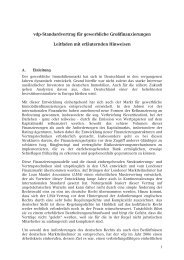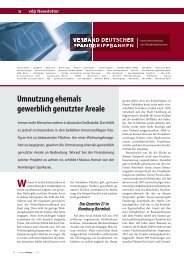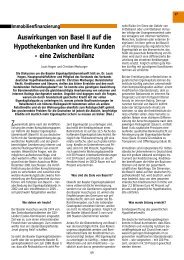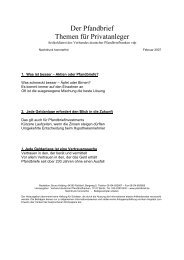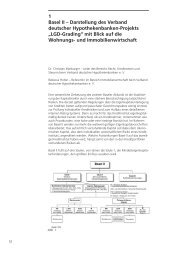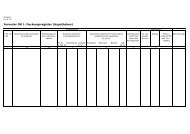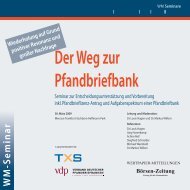The Pfandbrief 2011 | 2012
The Pfandbrief 2011 | 2012
The Pfandbrief 2011 | 2012
Create successful ePaper yourself
Turn your PDF publications into a flip-book with our unique Google optimized e-Paper software.
Roundtable <strong>Pfandbrief</strong> Banks<br />
tion among the rating agencies would seem necessary. However, it is likely to take many years<br />
before a new agency is established, as it would first have to earn investors’ confidence and be<br />
politically desired.<br />
HB: For <strong>Pfandbrief</strong> issuers wishing to place <strong>Pfandbrief</strong>e, there is no alternative to a rating.<br />
Banks which issue <strong>Pfandbrief</strong>e internationally and on a regular basis are even expected to provide<br />
two ratings. This makes it difficult to arrive at the necessary trade-off.<br />
BW: It is an unfortunate fact that covered bond ratings today depend primarily on the amount<br />
of overcollateralization, and that the quality of the legal framework which regulates covered<br />
bonds plays only a secondary role. After Fitch, in early 2009, downgraded the <strong>Pfandbrief</strong> ratings<br />
of <strong>Pfandbrief</strong> banks specializing in commercial property finance to “watch negative”,<br />
we consciously opted for an AA+ rating. But since investors face increasingly more – not less<br />
– regulatory requirements that are based on external ratings, issuers will have to continue having<br />
their <strong>Pfandbrief</strong>e rated by one of the agencies.<br />
60<br />
6.<br />
Investors suspect that a new bubble will result from real estate finance providers<br />
changing their business strategy to make commercial real estate their new core<br />
business. How will the trade-off between secured income and greater risk as well as<br />
stronger pressure on margins be reached?<br />
TS: For us, international commercial property finance is not a new core business field, but one<br />
we have engaged in for 20 years. Wide regional diversification substantially reduces dependence<br />
on individual real estate cycles and allows <strong>Pfandbrief</strong> investors to invest in a professionally<br />
managed International property portfolio.<br />
BW: For many years now, we have regarded commercial property finance – alongside credit<br />
for housing associations and cooperatives to finance multi-family dwellings – as our core<br />
business. In the past years, well over 90% of our new lending activities have at all times been<br />
categorized in the risk classes 1-7 of the DSGV master scale. Put simply, this is equivalent to<br />
the school grades “very good” and “good”. A conservative risk profile will remain our leitmotif<br />
in the future.<br />
7.<br />
Exactly what constitutes the “right” mortgage lending value was the subject of<br />
debate, particularly before the financial market crisis. In many European countries,<br />
mortgage lending limits sometimes clearly above 60% are permitted. What is more,<br />
these are often based on the market value rather than the mortgage lending value,<br />
the measure commonly used in Germany. Can raising the mortgage lending limit be<br />
justified? How high should it be for commercial loans and private mortgages?<br />
RG: Thanks not least to the conservative valuation approach applied, the <strong>Pfandbrief</strong> is the<br />
highest-quality product in the covered bond world. Given the proven low risk provisioning in<br />
the housing finance business, a higher mortgage lending value would be justifiable; investors<br />
would still recognize the high quality of the <strong>Pfandbrief</strong>.




